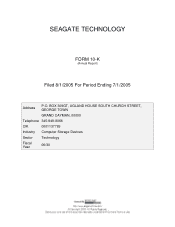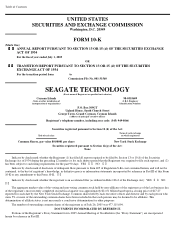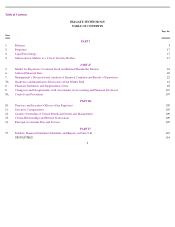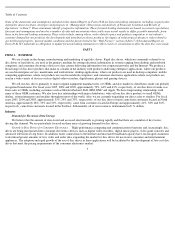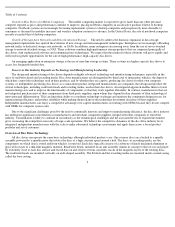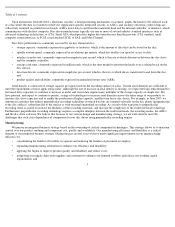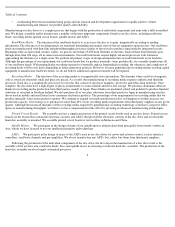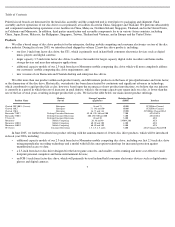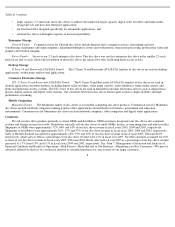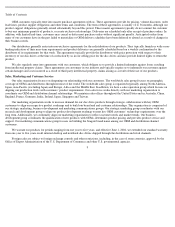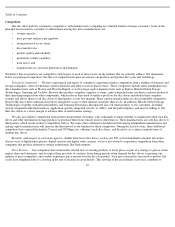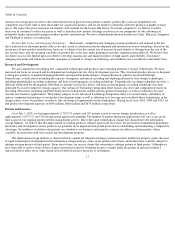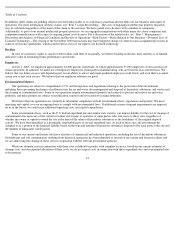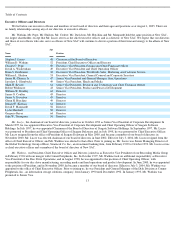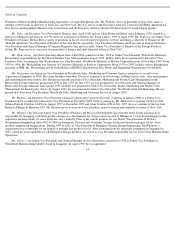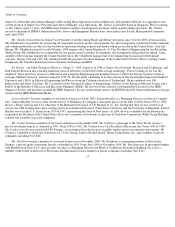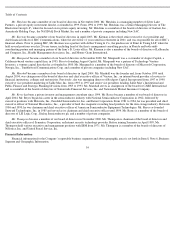Seagate 2004 Annual Report Download - page 8
Download and view the complete annual report
Please find page 8 of the 2004 Seagate annual report below. You can navigate through the pages in the report by either clicking on the pages listed below, or by using the keyword search tool below to find specific information within the annual report.
Table of Contents
Manufacturing our disc drives is a complex process that begins with the production of individual components and ends with a fully assembled
unit. We design, assemble and/or manufacture a number of the most important components found in our disc drives, including read/write
heads, recording media, printed circuit boards, spindle motors and ASICs.
Read/Write Heads . The function of the read/write head is to scan across the disc as it spins, magnetically recording or reading
information. The tolerances of recording heads are extremely demanding and require state-of-the-art equipment and processes. Our read/write
heads are manufactured with thin-film and photolithographic processes similar to those used to produce semiconductor integrated circuits.
Beginning with six-inch round ceramic wafers, we process more than 25,000 head elements at one time. Each of these head elements goes
through more than 300 steps, all in clean room environments. Our read/write heads require highly advanced processes with tolerances
approaching the thickness of a single atom. We perform all primary stages of design and manufacture of read/write heads at our facilities.
Although the percentage of our requirements for read/write heads that we produce internally varies periodically, we currently manufacture all
of our read/write heads. With perpendicular recording expected to eventually replace longitudinal recording, the tolerances and complexity of
recording heads will be even more demanding in future generation products. However, because perpendicular recording utilizes existing capital
equipment to manufacture read/write heads, we do not believe additional capital investment will be required.
Recording Media . The function of the recording media is to magnetically store information. The domains where each bit of magnetic
code is stored are extremely small and precisely placed. As a result, the manufacturing of recording media requires sophisticated thin-film
processes. Each disc is a sequentially processed set of layers that consist of structural, magnetic, protective and lubricating materials. Once
complete, the disc must have a high degree of physical uniformity to assure reliable and error-free storage. We purchase aluminum substrate
blanks for recording media production from third parties, mainly in Japan. These blanks are machined, plated and polished to produce finished
substrates at our plant in Northern Ireland. We also purchase all of our glass substrates from third parties in Japan in manufacturing our disc
drives used in mobile and small form factor consumer electronics products. The percentage of our requirements for recording media that we
produce internally varies from quarter to quarter. We continue to expand our media production facility in Singapore to further increase our
production capacity. Our strategy is to purchase no more than 20% of our recording media requirements from third-
party suppliers in any given
quarter. Although the increased thickness of the recording media required by perpendicular recording technology could have a negative effect
upon our manufacturing throughput, we believe we have compensated for this effect by investing in advanced manufacturing technologies.
Printed Circuit Boards . We assemble and test a significant portion of the printed circuit boards used in our disc drives. Printed circuit
boards are the boards that contain the electronic circuitry and ASICs that provide the electronic controls of the disc drive and on which the
head-disc assembly is mounted. We assemble printed circuit boards at our facilities in Malaysia and China.
Spindle Motors . We participate in the design of many of our spindle motors and purchase them principally from outside vendors in
Asia, whom we have licensed to use our intellectual property and technology.
ASICs . We participate in the design of many of the ASICs used in our disc drives for motor and actuator control, such as interface
controllers, read/write channels and pre-amplifiers. We do not manufacture any ASICs but, rather, buy them from third-party suppliers.
Following the production of the individual components of the disc drive, the first step in the manufacture of a disc drive itself is the
assembly of the actuator arm, read/write heads, discs and spindle motor in a housing to form the head-disc assembly. The production of the
head-disc assembly involves largely automated processes.
6
•
coordinating between our manufacturing group and our research and development organization to rapidly achieve volume
manufacturing and enhance our product quality and reliability.

